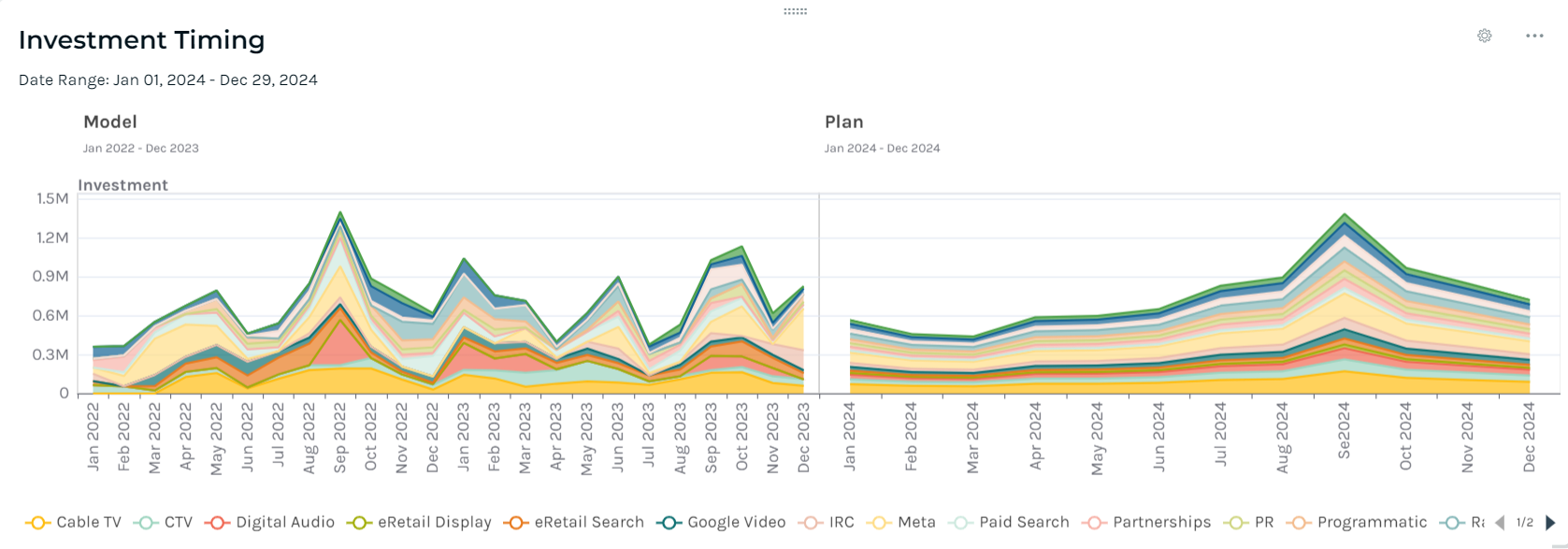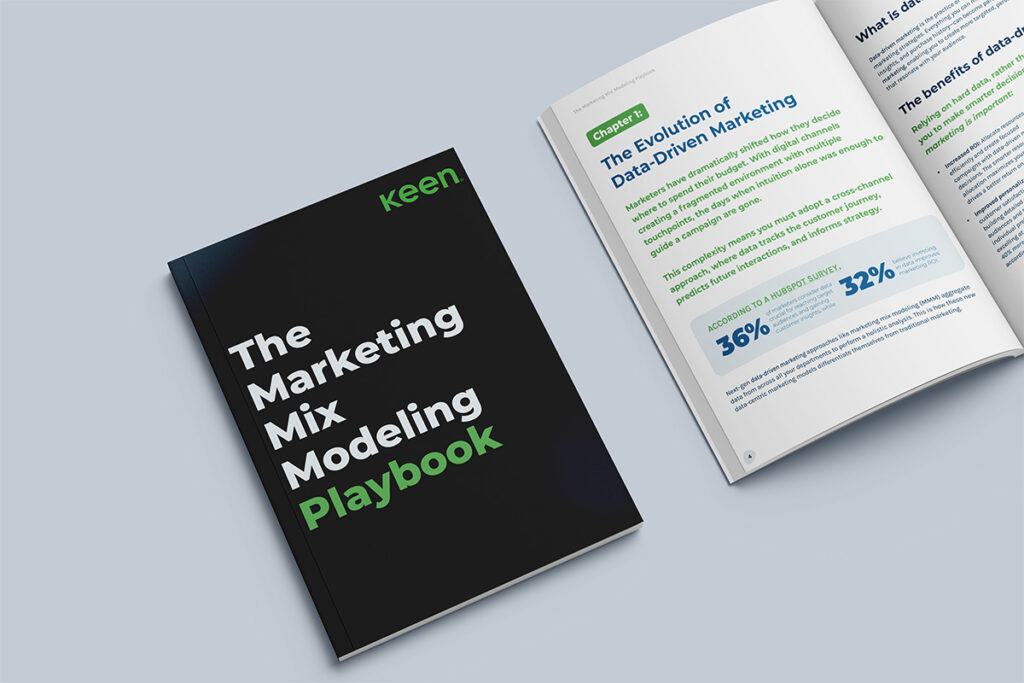Without clear direction, your marketing efforts will fail. But where do you start?
Establishing a detailed marketing strategy that incorporates a well-defined marketing mix guides you in selecting the right channels for your brand and how to best allocate your budget to achieve your objectives.
Let’s review the differences between marketing mix and marketing strategy and why mastering both is essential for optimizing media spending so you can make more informed decisions.
Are marketing mix and strategy the same?
The short answer is no. Marketing mix and marketing strategy are not the same.
Here’s what sets them apart:
- A marketing strategy lays out the big picture: it defines your goals and who you’re targeting.
- A marketing mix strategy gets into the details: what you’re offering, how you’ll sell it, where you’ll distribute it, and how much it’ll cost.
A strategy sets the direction, while the mix puts it into action, working together to direct your marketing plan. For example, the strategy might identify a specific target market, while the marketing mix would help specify how much budget to allocate per product, which channels to prioritize, and the appropriate pricing, distribution, and promotional methods to ensure the strategy is implemented effectively.
Marketing mix vs marketing strategy: Key differences
We’ve broken down the key differences between marketing mix and marketing strategy:
| Aspect | Marketing strategy | Marketing mix |
| Key elements | Goals, target audience definition, brand positioning, and competitive analysis | Decisions about the product, pricing structures, distribution channels, and promotional tactics |
| Scope | Broad and comprehensive, covering the entire marketing approach of the company | Specific and detailed, dealing with particular aspects of product, pricing, distribution, and promotion |
| Timeline | Long-term, often spanning several years | Short to medium-term, based on market conditions or performance |
| Performance metrics | Market share, brand awareness, and customer lifetime value | Sales volume, conversion rates, or channel effectiveness |
What is a marketing mix?
A marketing mix, or the 4 Ps of marketing, is a strategic framework that combines four factors brands use to influence consumer purchasing decisions. The goal of defining a marketing mix is to maximize value and create effective marketing campaigns.
The 4 Ps of a marketing mix are:
- Product: The goods or services a business provides to fulfill customer needs
- Price: The cost customers pay, determined by market demand, competitor pricing, and perceived value
- Place: The distribution channels used to make the product accessible, whether online or in retail stores
- Promotion: The communications employed to inform and persuade customers, including advertising and social media strategies
When developing a mix, all 4 Ps work together to reach your target audience and align with your overall marketing strategy. Just keep in mind:
- Mixes often neglect service offering aspects, treating them as part of the product category rather than addressing them specifically.
- Mixes also fail to cover critical activities like packaging, which are typically subsumed under other elements of the mix.
- The four Ps focus primarily on the seller’s perspective rather than prioritizing the buyer’s needs and preferences.
Learn how to develop a marketing mix strategy.
What is marketing strategy?
A marketing strategy is a blueprint that outlines how a company will achieve its marketing objectives by identifying its audience, setting goals, and defining its brand’s unique value.
Similar to the 4 Ps of a mix, marketing strategies follow the 4 Cs, which offer a customer-focused framework emphasizing customer satisfaction and engagement.
The 4 Cs of marketing strategy are:
- Customer: Analyze your target audience’s needs, preferences, and behaviors to pinpoint their value in your product or service.
- Cost: Assess the total cost of ownership from the customer’s perspective, factoring in the purchase price and any additional fees to ensure pricing aligns with perceived value.
- Convenience: Optimize the ease of purchasing and using your product or service by enhancing accessibility, refining purchasing channels, and improving the overall customer experience.
- Communication: Ensure your marketing messages resonate with your audience, foster strong relationships, and deliver relevant information to engage customers effectively.
When building a successful and unified marketing strategy, analyze your target audience, current conditions, and competitive landscape to successfully meet business objectives. Keep in mind:
- Marketing strategies often miss crucial tactical execution details, as they emphasize broad and long-term objectives without addressing the specific actions needed for day-to-day operations. The focus on high-level annual planning can lead to gaps in practical implementation.
- Strategies may lack the flexibility required to support change in market conditions or immediate customer needs, potentially resulting in outdated or ineffective approaches.
Why a marketing mix shouldn’t exist without a strategy
While a marketing mix can exist without a formal strategy, it’s generally not advisable.
Without a clear marketing strategy, the mix lacks direction, leading to disconnected decisions. Efforts go out of sync with goals and lack long-term vision, making marketing investments reactive rather than strategic.
Marketing strategies are essential for meeting long-term goals. In fact, according to CoSchedule, companies equipped with a marketing strategy are 331% more successful than those without one.
Keen can help you create or optimize your marketing mix. Our marketing mix modeling platform integrates into each stage of your planning process to help you monitor and better understand your marketing budget.
By running various scenarios mirroring marketing factors, you can make educated decisions to shape your mix. You can also automate data loading and measure marketing results across all channels to ensure you are prepared for future hurdles.
How do real brands use marketing strategy and marketing mix together?
The most effective marketing teams don’t treat strategy and execution as separate exercises. Instead, they build a clear marketing strategy and marketing mix that support each other, using data to align long-term goals with day-to-day tactics.
Let’s break down two Keen case studies that show how brands across different industries and investment levels successfully integrated marketing mix and strategy to drive measurable results.
Dramamine
Dramamine’s team came to Keen with a seasonal marketing strategy focused on summer travel. The company was focused solely on marketing during peak seasonal periods and was hesitant to invest in other times throughout the year.
With support from Keen, the team used scenario-based modeling to explore how marketing mix strategies outside the traditional season could impact performance. Simulations showed that reallocating their media mix across more weeks of the year could deliver twice the return.
The outcome was a smarter, year-round marketing mix that supported a more dynamic strategy. Dramamine saw a profitable 41.8% in incremental revenue and a 9.5% increase in marketing ROI.

National skincare brand
A 175-year-old skincare brand partnered with Keen to modernize its marketing strategy while protecting its long-standing reputation. Facing limited budgets and pressure to grow in both body care and hair care, the team needed a more agile and precise approach to investment.
Keen enabled the team to analyze four years of historical performance and test multiple investment scenarios, including budget increases of 8%, 10%, and 15%. This exercise revealed where to reallocate spend across TV, influencer, and trade channels to maximize impact.
The brand’s revised strategy blended tradition with innovation, and the optimized marketing mix helped them act on it. The outcomes?
- Increased marketing contribution to base growth
- Optimized media mix across constrained and unconstrained scenarios
- Sustained year-over-year growth with an agile investment strategy
Explore our guide to marketing mix modeling optimization.
Optimize your marketing mix and strategy with Keen
Understanding the differences between marketing mix and marketing strategy is a great start. But to make the most out of your marketing dollars, you need the right tools.
With Keen, you can leverage AI in media planning, better unifying data and forecasting your results. We help you optimize your marketing mix and strategy, connecting efforts to clear financial outcomes.
See for yourself. Start your free trial with Keen now.
Frequently asked questions
Is marketing mix a marketing strategy?
No. While the marketing mix is often referred to as a type of strategy, it’s more accurate to think of it as a component of your overall marketing strategy.
Your marketing strategy sets the vision by defining your target audience, positioning, and business objectives. The marketing mix brings that strategy to life through four key levers: product, price, place, and promotion.
Think of it this way: strategy is the “what” and “why,” while the mix is the “how.” For a successful marketing approach, you need both.
How can you balance the four Ps of the marketing mix with the four Cs of marketing strategy?
To balance the four Ps (product, price, place, and promotion) with the four Cs (customer, cost, convenience, and communication), you can map each element of the marketing mix to its customer-focused counterpart in your marketing strategy.
Start by aligning product with customer needs, price with perceived cost, place with convenience, and promotion with meaningful communication. This process ensures that your internal decisions align with how your audience thinks and buys.
How do market dynamics influence the marketing mix and strategy?
Market dynamics such as changes in consumer behavior, economic conditions, or competitive pressure have a direct impact on your marketing mix and strategy. As demand shifts or new channels emerge, brands need to adjust how they price, promote, and distribute their offerings to stay competitive.
For example, suppose digital consumption patterns change and your core audience is no longer responding to the same high-performing channels. In that case, your promotion strategy may need to pivot, refocusing spend, adjusting messaging, or rebalancing brand versus performance.
What are the differences between marketing plan and marketing mix?
Marketing plan and marketing mix serve two distinct roles within a broader marketing strategy:
- A marketing plan outlines your strategic goals, target audience, budget, and performance metrics over a set period.
- The marketing mix refers to the tactical elements you use to execute that plan—product, price, place, and promotion.
In short, the plan tells you where you’re going and why. The mix tells you how you’ll get there.
Marketing strategy vs marketing plan: How do you differentiate the two concepts?
The difference between a marketing strategy vs marketing plan comes down to vision versus execution. A marketing strategy defines your long-term goals, target audience, and brand positioning.
A marketing plan turns that strategy into action, laying out the campaigns, timelines, budgets, and tactics—such as media buying, content creation, or sales promotion—that will bring the strategy to life.
Marketing mix and target market: How do they work together in a successful strategy?
Marketing mix and target market are closely linked, as your product, price, place, and promotion decisions should be tailored to the specific needs and preferences of the audience you’re trying to reach. When you know your target market well, you can shape the mix to improve relevance, increase conversions, and strengthen loyalty.
Here’s how the four Ps should adapt to fit your audience:
| Marketing mix element | What to consider based on your target market |
| Product | Does your product solve a real need for your audience? Are features aligned with their preferences, values, or usage habits? |
| Price | What price point feels accessible or premium to them? Are they cost-conscious or value-driven? |
| Place | Where do they shop: online, in-store, via marketplaces? How do they prefer to discover or purchase products? |
| Promotion | What channels do they trust and engage with? What messaging resonates based on their priorities or pain points? |





